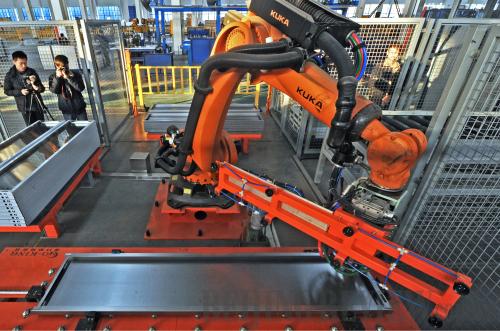|
 |
|
UNMANNED WELDING: Workers take photos of the robot welding production line in a plant owned by Sicher Elevator Co. Ltd., where 1.65 billion yuan ($263 million) has been invested in replacing workers with robots (TAN JIN) |
In warehouses, red automatic guided vehicles transport mechanical parts and components. Mechanical arms assemble these parts, while automatic spraying robots paint them. The result is a finished product. In the unmanned digital factory of Siasun Robot & Automation Co. Ltd., located in Huzhou of east China's Zhejiang Province, all of these production processes are executed by robots.
"Robotic production is five to 10 times more efficient than manual operation," said Ha Enjing, head of the Brand Promotion and Public Relations Department of Siasun.
The rapid expansion of industrial robots has been primarily spurred by rising labor costs in recent years. For many equipment manufacturing enterprises, industrial robots that have automation and intelligent identification capabilities can greatly relieve cost pressures on them.
According to the International Federation of Robotics (IFR), 36,560 industrial robots were sold in China in 2013, making the country the world's largest robot market in terms of annual sales. Statistics from the China Robot Industry Alliance also showed that in the first three quarters of 2014, sales of industrial robots in China continued experiencing high-speed growth, hitting 33,600 units, a year-on-year increase of 32.5 percent.
As the automation of automobile and electronics factories continues, IFR predicted that the number of robots employed by Chinese factories will be second to none in 2017. In China, every 10,000 workers have access to 30 robots, while in South Korea, Japan, Germany and the United States, every 10,000 workers use 437, 323, 282 and 152 robots in production respectively. That is to say, China is the largest potential market, but the density of robots in use is far lower than in developed countries.
As Wuhan Huazhong Numerical Control Co. Ltd., a leading computer numerical control manufacturer, predicted, the demand for industrial robots in automobile manufacturing, the food and beverage industry, chemical engineering, plastics production, and rubber and metal products will amount to 1.08 million to 2.4 million in the next few years, accounting for 70 percent of the total demand.
"In the past, the utilization of industrial robots concentrated in the automobile industry. In recent years, however, it has expanded into metal processing, food and beverages, and so on," said Dun Xiangming, a research fellow with the Robotics Institute of Shanghai Jiaotong University, in an interview with Oriental Outlook magazine.
Dun stated the electronics industry, especially home appliance and cellphone manufacturing, will be the largest potential market for industrial robots in the future. Moreover, industries such as photoelectrics manufacturing, iron and steel production and biochemical and pharmaceutical products will also witness a rise of industrial robots owing to the present limitations on their production environment.
Technological gridlock
Gao Junyao, Deputy Director of the Intelligent Robot Institute under the Beijing Institute of Technology (BIT), noted that the industrialization of Chinese-made robots coincides with the surge of its domestic demand, which has greatly streamlined production.
According to statistics from the Shenzhen-based GaoGong Robotics Industry Institute, there exist a total of 428 robot-related enterprises in China as of September 2014. Of those, 175 were established in the first three quarters of 2014.
As a matter of fact, many Chinese enterprises in the robotics industry do not yet possess their own laboratories, research and development (R&D) teams or testing methods, said Luo Jun, President of the Beijing-based Asian Manufacturing Association.
Zhang Tianjiang, General Manager of Tianjin Easy-Robot Science & Technology Development Co. Ltd., noted that most newly established enterprises are engaged in robotic assembling and copying. They gain knowledge of foreign-made robot structure by taking the models apart, then purchasing materials and components to assemble their own products.
"There has been an imbalance between R&D and application. In other words, some technologies may prove to be perfect in the laboratory but defective in practice," said Gao, who concluded the weaknesses of domestic-made robots owe to the lagging development of application systems and the inability to develop core components and parts.
"In fact, robots can't go into service immediately after being purchased. Take welding robots for example. Before they can be put into operation, the factory has to develop a set of welding-related application systems," said Wang Tianmiao, a professor from the Robotics Institute of Beihang University in Beijing.
|
